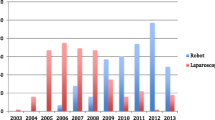Background: Increasing numbers of laparoscopic surgeons are performing laparoscopic Roux-en-Y gastric bypass (LGB). Our aim was to determine the length of the learning curve for a skilled laparoscopic surgeon. Methods: The study population consisted of the first 225 consecutive LGB procedures attempted by one laparoscopic surgeon (HJS). Outcome parameters included mortality, morbidity, operative time, and conversion to an open procedure. Results: Average operative time decreased from 189 min (first 75 patients) to 125 minutes (last 75 patients). Most of the improvement in operative time occurred over the first 75 patients. The perioperative complication rate decreased from 32% (first 75 patients) to 15% (second and third groups of 75 patients). Complication rates did not significantly decrease after the first 75 patients. Low mortality and conversion rates were achieved early in the series. Conclusion: Low mortality rates and low conversion rates can be achieved early in the learning curve for LGB. Complication rates plateau after approximately 75 LGBs, and operative times decrease substantially over the initial 75 cases. Operative times continue to decrease at a slower rate beyond 75 cases.
Similar content being viewed by others
Author information
Authors and Affiliations
Rights and permissions
About this article
Cite this article
Oliak, D., Ballantyne, G., Weber, P. et al. Laparoscopic Roux-en-Y gastric bypass . Surg Endosc 17, 405–408 (2003). https://doi.org/10.1007/s00464-002-8820-z
Received:
Accepted:
Issue Date:
DOI: https://doi.org/10.1007/s00464-002-8820-z




